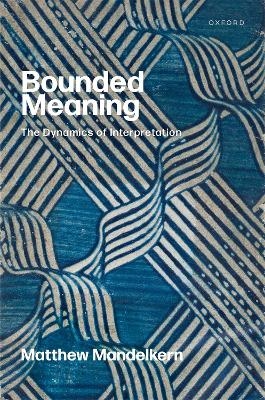
Bounded Meaning
The Dynamics of Interpretation
Seiten
2024
Oxford University Press (Verlag)
978-0-19-287004-9 (ISBN)
Oxford University Press (Verlag)
978-0-19-287004-9 (ISBN)
Bounded Meaning develops a new theory of how and why semantic interpretation depends not just on global information, but also on local information. Mandelkern provides criticisms of the dominant theory, dynamic semantics, and proposes a new theory of bounds as limits on admissible interpretations of an expression.
Bounded Meaning investigates the dynamics of interpretation: how and why the interpretation of the building blocks of human language is sensitive, not just to the context in which the expression is used, but also to the expression's linguistic environment—in other words, how and why interpretation depends not just on global information, but also on local information. Matthew Mandelkern motivates a range of generalizations about the dynamics of interpretation, some known and some novel, involving modals, conditionals, and anaphora, and an overview of the best extant theory of those patterns, dynamic semantics, is provided. After bringing out the striking motivations and successes of that framework, the discussion turns to criticisms of dynamic semantics, focusing on its puzzling predictions about the logic of natural language. In response to these problems, Mandelkern develops a novel framework for explaining dynamic phenomena without dynamic semantics: the bounded theory of meaning. On the bounded theory, dynamic phenomena arise from the interaction of two dimensions of meaning. One dimension is a standard truth-conditional layer, which, relative to a context of use, associates each sentence with a proposition. The second dimension, the dimension of bounds, limits the admissible interpretations of an expression, relative to the expression's context of use and its local information. Bounds thus play an essential role in coordinating on the resolution of context-sensitive language, explaining dynamic effects in natural language while avoiding a variety of problematic predictions of dynamic semantics.
Bounded Meaning investigates the dynamics of interpretation: how and why the interpretation of the building blocks of human language is sensitive, not just to the context in which the expression is used, but also to the expression's linguistic environment—in other words, how and why interpretation depends not just on global information, but also on local information. Matthew Mandelkern motivates a range of generalizations about the dynamics of interpretation, some known and some novel, involving modals, conditionals, and anaphora, and an overview of the best extant theory of those patterns, dynamic semantics, is provided. After bringing out the striking motivations and successes of that framework, the discussion turns to criticisms of dynamic semantics, focusing on its puzzling predictions about the logic of natural language. In response to these problems, Mandelkern develops a novel framework for explaining dynamic phenomena without dynamic semantics: the bounded theory of meaning. On the bounded theory, dynamic phenomena arise from the interaction of two dimensions of meaning. One dimension is a standard truth-conditional layer, which, relative to a context of use, associates each sentence with a proposition. The second dimension, the dimension of bounds, limits the admissible interpretations of an expression, relative to the expression's context of use and its local information. Bounds thus play an essential role in coordinating on the resolution of context-sensitive language, explaining dynamic effects in natural language while avoiding a variety of problematic predictions of dynamic semantics.
Matthew Mandelkern is Assistant Professor of Philosophy at New York University. He received a PhD in Philosophy from MIT. He was a Post-Doctoral Research Fellow at All Souls College, Oxford, 2017-2020. He works on the philosophy of language and its intersections with neighbouring fields.
1: Introduction
Part I: Modals and Conditionals
2: The Dynamics of Modality
3: The Dynamics of Conditionals
4: Against Dynamic Semantics
5: Bounded Modals and Conditionals
Part II: Conditionals: Reasoning and Probability
6: Reasoning with Conditionals
7: Probabilities of Conditionals
Part III: Anaphora
8: The Dynamics of Anaphora
9: Bounded Anaphora
10: Quantification and Subordination
Part IV: Concluding
11: Local Contexts
12: Conclusion
| Erscheinungsdatum | 22.08.2024 |
|---|---|
| Verlagsort | Oxford |
| Sprache | englisch |
| Maße | 165 x 240 mm |
| Gewicht | 616 g |
| Themenwelt | Geisteswissenschaften ► Philosophie ► Logik |
| Geisteswissenschaften ► Philosophie ► Sprachphilosophie | |
| Geisteswissenschaften ► Sprach- / Literaturwissenschaft ► Sprachwissenschaft | |
| ISBN-10 | 0-19-287004-1 / 0192870041 |
| ISBN-13 | 978-0-19-287004-9 / 9780192870049 |
| Zustand | Neuware |
| Informationen gemäß Produktsicherheitsverordnung (GPSR) | |
| Haben Sie eine Frage zum Produkt? |
Mehr entdecken
aus dem Bereich
aus dem Bereich
ein Gegenentwurf zum kurzfristigen Denken : so werden wir zu den …
Buch | Hardcover (2023)
REDLINE (Verlag)
CHF 27,90
Buch | Softcover (2023)
De Gruyter (Verlag)
CHF 34,90


